Control Strategy of the Pumped Storage Unit to Deal with the Fluctuation of Wind and Photovoltaic Power in Microgrid
Abstract
1. Introduction
2. The Model Construction of Units Combined Operation in Microgrid
2.1. The Objective Function
2.2. Operating Constraints of Various Types of Units in Microgrid
3. New Control Strategy for Combined Operation of Units in Microgrid
3.1. Evaluation Index of the Effect of the New Control Strategy on the Stabilization of Fluctuation
- (1)
- Time predicts period T0: It can be seen from the forecast of wind-solar power that there are certain deviations in the forecast results, which is the forecast accuracy. In order to better verify the feasibility of the proposed strategy, we assume that the prediction accuracy of wind-solar power is a fixed value within the prediction period.
- (2)
- Fluctuation of unit combined output power ΔPyt: The difference between combined units output power at any time t1 and t2.where Pyt is the combined output power value within the prediction period. t1 and t2 are any two time points in the scheduling cycle. Let Δt = t2 − t1, and Equation (16) can be expressed as:
- (3)
- Maximum allowable deviation for power fluctuation Dt: Refers to the maximum limit of allowable fluctuation of wind-solar power. Through the combined operation of the pumped storage power station, the wind and photovoltaic output power is smoothed so that the power change is controlled within the set range. That is:Due to the different scale of microgrid system, the acceptable range of wind power and photovoltaic power fluctuation is also different. Therefore, the setting of Dt value should be determined according to the actual situation of microgrid.
- (4)
- The total amount of electrical energy in excess of the fluctuation limit Wpass: That is, in the prediction period, the power fluctuation at all adjacent moments exceeds the sum of the differences of the maximum allowable deviation.
- (5)
- The ratio of the total time when the output fluctuation exceeds the maximum deviation to the dispatching cycle Ppass: That is, the percentage of the total time when the power fluctuation difference of any two moments exceeds the maximum allowable deviation in the prediction period.
3.2. Traditional Combined Unit Scheduling Strategy
3.3. New Combined Unit Scheduling Strategy
- (1)
- Maintain the same state: That is, in the forecast period, the fluctuation of wind-solar power at any time conforms to the specified allowable deviation Dt, and then the output of unit 1 and 2 is not required to stabilize the fluctuation, which is satisfied:
- (2)
- Unit generation regulation: When ΔPt = Py(t+Δt) − Pwt − Pvt > Dt, which means the next moment the wind-solar power will drop dramatically and cause a large deviation, the need for unit 1 reservoir sluice generation regulation, at this time Pg,t > 0, or when the wind-solar power meets the deviation allowable constraint −Dt < ΔPt < Dt at this time, but within the prediction period, it is predicted that there will be ΔPt+kΔt = Py(t+kΔt) − Pwt − Pvt < −Dt at a certain time k in the future. That is, there will be a large number of wind-solar power abandonment. Therefore, unit 2 reservoir is required to conduct pumped storage operation for regulation, but due to the limitation of reservoir capacity, wind and solar electricity cannot be completely absorbed. Therefore, in order to better stabilize the power fluctuation, unit 2 needs to generate part of the electric energy appropriately on the basis of meeting the operating constraints, so as to give consideration to the problem of insufficient capacity at time t + kΔt. The specific expression is:where: k = 1, 2, 3, ..., T/Δt.
- (3)
- Unit energy storage regulation: Similarly, when ΔPt = Py(t+Δt) − Pwt − Pvt < −Dt, a large amount of wind-solar power abandoning is generated, and unit 2 is required to conduct energy storage regulation, at this time Pp,t < 0. Or, when the wind-solar power meets the deviation allowable constraint −Dt < ΔPt < Dt at this time, but within the prediction period, something is predicted to happen ΔPt+kΔt = Py(t+kΔt) − Pwt − Pvt > Dt at a certain time k in the future. That is, the wind-solar output power will decrease sharply. Unit 1 reservoir is required to conduct power generation operation to control, but at this time, there is not enough water in the upstream reservoir of unit 1 to generate power and maintain; on the basis of unit 1 meeting operating constraints, it is necessary to store part of the water appropriately, so as to take into account the stability of the combined output of wind power, photovoltaic power, and pumped storage power at time t + kΔt. The specific expression is:where: k = 1, 2, 3, ..., T/Δt.
4. Improved Social Particle Swarm Optimization
4.1. Social Particle Swarm Optimization
4.2. The Improvement Strategy of Inertia Weight ω
5. Example Analysis
5.1. System Example Summarize
5.2. Example Result
5.3. Different Algorithm Results Comparison
6. Conclusions
Author Contributions
Funding
Conflicts of Interest
References
- Reddy, S.S.; Bijwe, P.R. Real time economic dispatch considering renewable energy resources. Renew. Energy 2015, 83, 1215–1226. [Google Scholar] [CrossRef]
- Kherfane, N.; Kherfane, R.L.; Younes, M.; Khodja, F. Economic and Emission Dispatch with Renewable Energy Using HSA. Energy Procedia 2014, 50, 970–979. [Google Scholar] [CrossRef]
- Yang, Y.; Zhai, R.; Duan, L.; Ondrej, M.; John, O. Study on multi-objective optimization of load dispatch including renewable energy and CCS technologies. Int. J. Energy Res. 2009, 34, 702–715. [Google Scholar]
- Castronuovo, E.D.; Usaola, J.; Bessa, R.; Matos, M.; Cost, I.C.; Bremermann, L.; Lugaro, J.; Kariniotakis, G. An integrated approach for optimal coordination of wind power and hydro pumping storage. Wind. Energy 2014, 17, 829–852. [Google Scholar] [CrossRef]
- Surender Reddy, S.; Bijwe, P.R.; Abhyankar, A.R. Real-Time Economic Dispatch Considering Renewable Power Generation Variability and Uncertainty Over Scheduling Period. IEEE Syst. J. 2014, 9, 1440–1451. [Google Scholar] [CrossRef]
- Osório, G.J.; Lujano-Rojas, J.M.; Matias, J.C.O.; Catalão, J.P.S. A probabilistic approach to solve the economic dispatch problem with intermittent renewable energy sources. Energy 2015, 82, 949–959. [Google Scholar] [CrossRef]
- Yuan, T.J.; Chao, Q.; Li, Y.-Y.; Toerxun, Y. Short-term Wind Power Output Forecasting Model for Economic Dispatch of Power System Incorporating Large-scale Wind Farm. Proc. CSEE 2010, 30, 23–27. [Google Scholar]
- Wang, X.; Wang, J.; Tian, B.; Cui, Y.; Zhao, Y. Economic Dispatch of the Low-Carbon Green Certificate with Wind Farms Based on Fuzzy Chance Constraints. Energies 2018, 11, 943. [Google Scholar] [CrossRef]
- Antonanzas, J.; Osorio, N.; Escobar, R.; Urraca, R.; Martinez-de-Pison, F.J.; Antonanzas-Torres, F. Review of photovoltaic power forecasting. Sol. Energy 2016, 136, 78–111. [Google Scholar] [CrossRef]
- Kuo, P.-H.; Huang, C.-J. A Green Energy Application in Energy Management Systems by an Artificial Intelligence-Based Solar Radiation Forecasting Model. Energies 2018, 11, 819. [Google Scholar] [CrossRef]
- Yao, W.; Deng, C.; Li, D.; Chen, M.; Peng, P.; Zhang, H. Optimal Sizing of Seawater Pumped Storage Plant with Variable-Speed Units Considering Offshore Wind Power Accommodation. Sustainability 2019, 11, 1939. [Google Scholar] [CrossRef]
- Nko, M.; Chowdhury, S.D.; Popoola, O. Application Assessment of Pumped Storage and Lithium-Ion Batteries on Electricity Supply Grid. Energies 2019, 12, 2855. [Google Scholar] [CrossRef]
- Duque, A.J.; Castronuovo, E.D.; Sánchez, I.; Usaola, J. Optimal operation of a pumped-storage hydro plant that compensates the imbalances of a wind power producer. Electr. Power Syst. Res. 2011, 81, 1767–1777. [Google Scholar] [CrossRef]
- Xu, F.; Chen, L.; Jin, H.; Liu, Z. Modeling and Application Analysis of Optimal Joint Operation of Pumped Storage Power Station and Wind Power. Autom. Electr. Power Syst. 2013, 37, 149–154. [Google Scholar]
- Helseth, A.; Gjelsvik, A.; Mo, B.; Linnet, Ú. A model for optimal scheduling of hydro thermal systems including pumped-storage and wind power. IET Gener. Transm. Distrib. 2013, 7, 1426–1434. [Google Scholar] [CrossRef]
- Manolakos, D.; Papadakis, G.; Papantonis, D.; Kyritsis, S. A stand-alone photovoltaic power system for remote villages using pumped water energy storage. Energy 2004, 29, 57–69. [Google Scholar] [CrossRef]
- Zhu, Y.; Zou, Z.; Huang, W.; Wang, L.; Ma, G. The water, Wind and Solar Power Complementary Operation Research for Typical Power Station in Upper Reaches of Jinsha River. J. Hydroelectr. Eng. 2017, 36, 78–85. [Google Scholar]
- Liu, F.; Pan, Y.; Yang, J.; Zhou, J.; Zhou, J.; Zhu, Z.; Li, Q. Unit Commitment Model for Combined Optimization of Wind Power-Thermal Power-Pumped Storage Hydro. Proc. CSEE 2015, 35, 766–775. [Google Scholar]
- Oskouei, M.Z.; Yazdankhah, A.S.A. Scenario-based stochastic optimal operation of wind, photovoltaic, pump-storage hybrid system in frequency- based pricing. Energy Convers. Manag. 2015, 105, 1105–1114. [Google Scholar] [CrossRef]
- Yi, P.F.; Zhang, J.; Zhang, Z.Y. Modeling and Practice of Wind/PV/Pumped-Storage Hybrid System. Appl. Mech. Mater. 2014, 541-542, 892–897. [Google Scholar] [CrossRef]
- Rakhshan, M.; Vafamand, N.; Khooban, M.-H.; Blaabjerg, F. Maximum Power Point Tracking Control of Photovoltaic Systems: A Polynomial Fuzzy Model-Based Approach. IEEE J. Emerg. Sel. Top. Power Electron. 2017, 6, 292–299. [Google Scholar] [CrossRef]
- Akagi, S.; Yoshizawa, S.; Ito, M.; Fujimoto, Y.; Miyazaki, T.; Hayashi, Y.; Tawa, K.; Hisada, T.; Yano, T. Multipurpose control and planning method for battery energy storage systems in distribution network with photovoltaic plant. Int. J. Electr. Power Energy Syst. 2020, 116, 105485. [Google Scholar] [CrossRef]
- Jabir, M.; Azil Illias, H.; Raza, S.; Mokhlis, H. Intermittent smoothing approaches for wind power output: A review. Energies 2017, 10, 1572. [Google Scholar] [CrossRef]
- Khare, A.; Rangnekar, S. A review of particle swarm optimization and its applications in Solar Photovoltaic system. Appl. Soft Comput. 2013, 13, 2997–3006. [Google Scholar] [CrossRef]
- Cai, J.; Ma, X.; Li, L.; Peng, H. Chaotic particle swarm optimization for economic dispatch considering the generator constraints. Energy Convers. Manag. 2007, 48, 645–653. [Google Scholar] [CrossRef]
- Wang, X.; Chen, S.; Zhou, Y.; Wang, J.; Cui, Y. Optimal Dispatch of Microgrid with Combined Heat and Power System Considering Environmental Cost. Energies 2018, 11, 2493. [Google Scholar] [CrossRef]
- Ren, Y.; Zheng, Y.; Li, Y.P.; Huang, J.J.; Zhang, D. Modeling and Optimization of Hybrid Wind/PV Pumped-Storage Power System. Appl. Mech. Mater. 2011, 48–49, 693–696. [Google Scholar] [CrossRef]
- Yan, R.; Yuan, Z. Optimal Design of PV/Wind/Pumped-Storage Hybrid System Based on Improved Particle Swarm Optimization. J. Comput. Theor. Nanosci. 2012, 6, 660–663. [Google Scholar] [CrossRef]
- Petrakopoulou, F.; Robinson, A.; Loizidou, M. Simulation and analysis of a stand-alone solar-wind and pumped-storage hydropower plant. Energy 2016, 96, 676–683. [Google Scholar] [CrossRef]
- Ghasemi, A.; Enayatzare, M. Optimal energy management of a renewable-based isolated microgrid with pumped-storage unit and demand response. Renew. Energy 2018, 123, 460–474. [Google Scholar] [CrossRef]
- González, I.; Calderón, A.J. Integration of open source hardware Arduino platform in automation systems applied to Smart Grids/Micro-Grids. Sustain. Energy Technol. Assess. 2019, 36, 100557. [Google Scholar] [CrossRef]
- Yunxin, Z.; Yunquan, S. Control strategy of a hybrid energy storage in wind-solar hybrid generation micro-grid. Power Syst. Prot. Control. 2015, 43, 93–98. [Google Scholar]
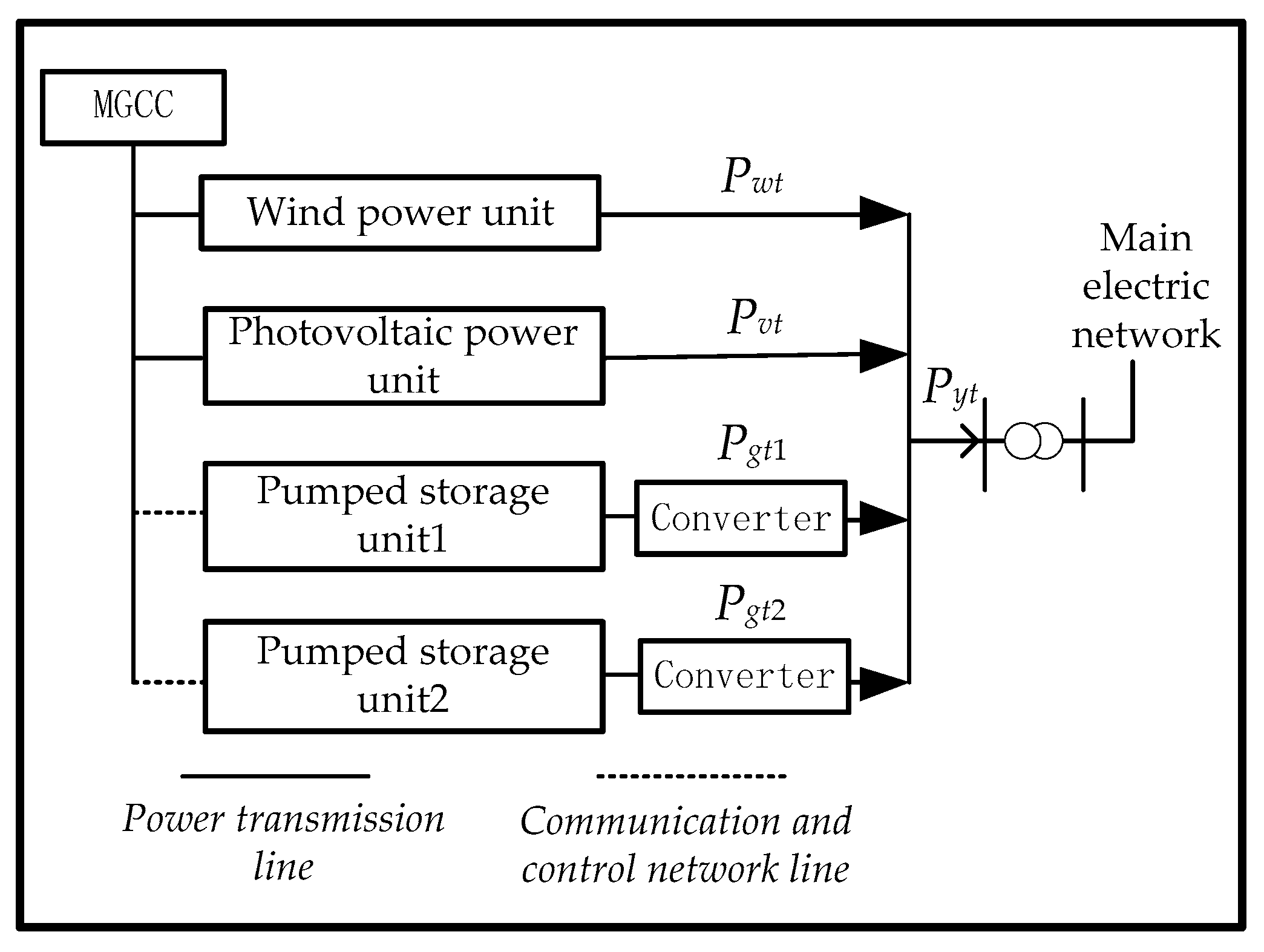


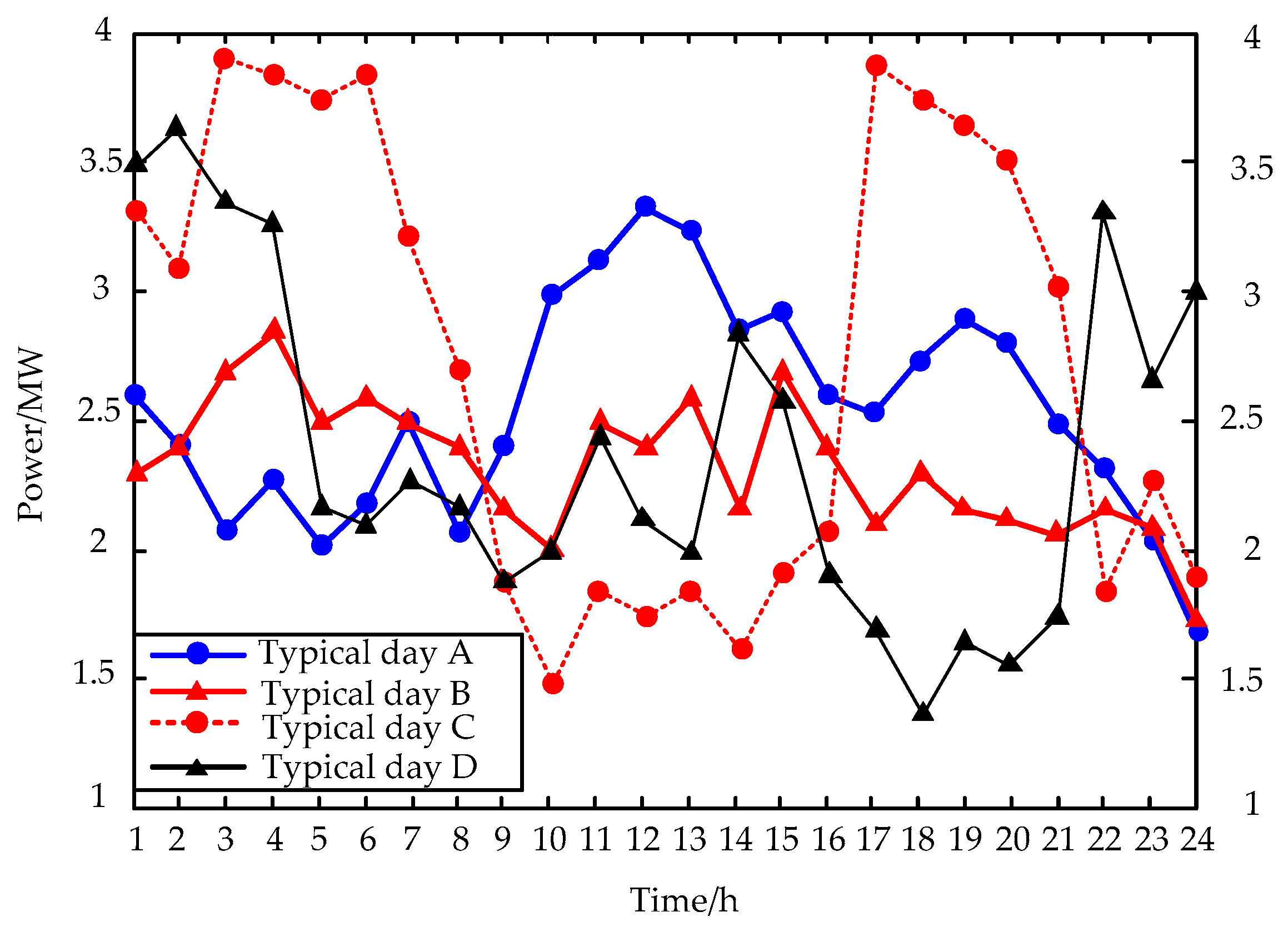





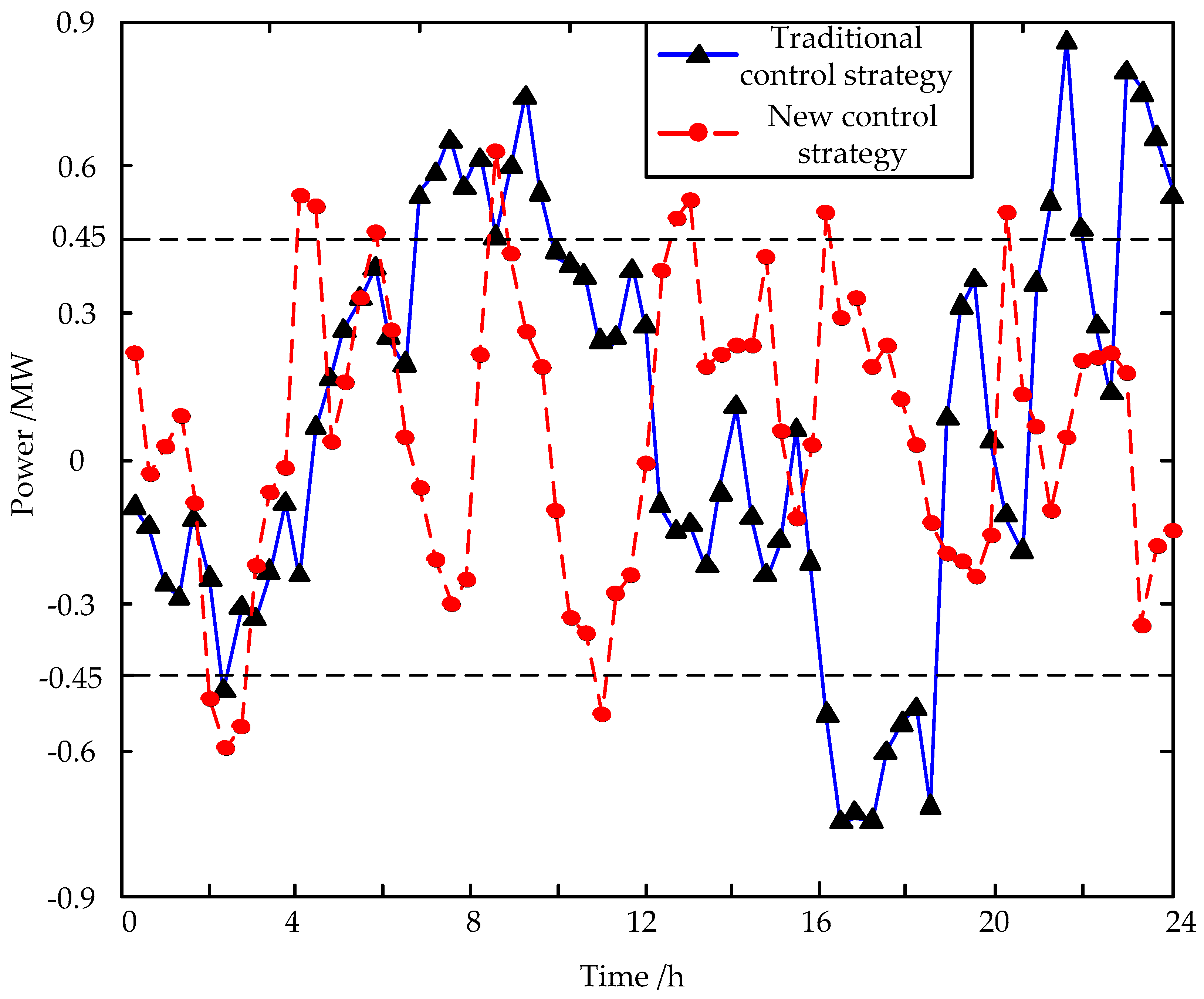


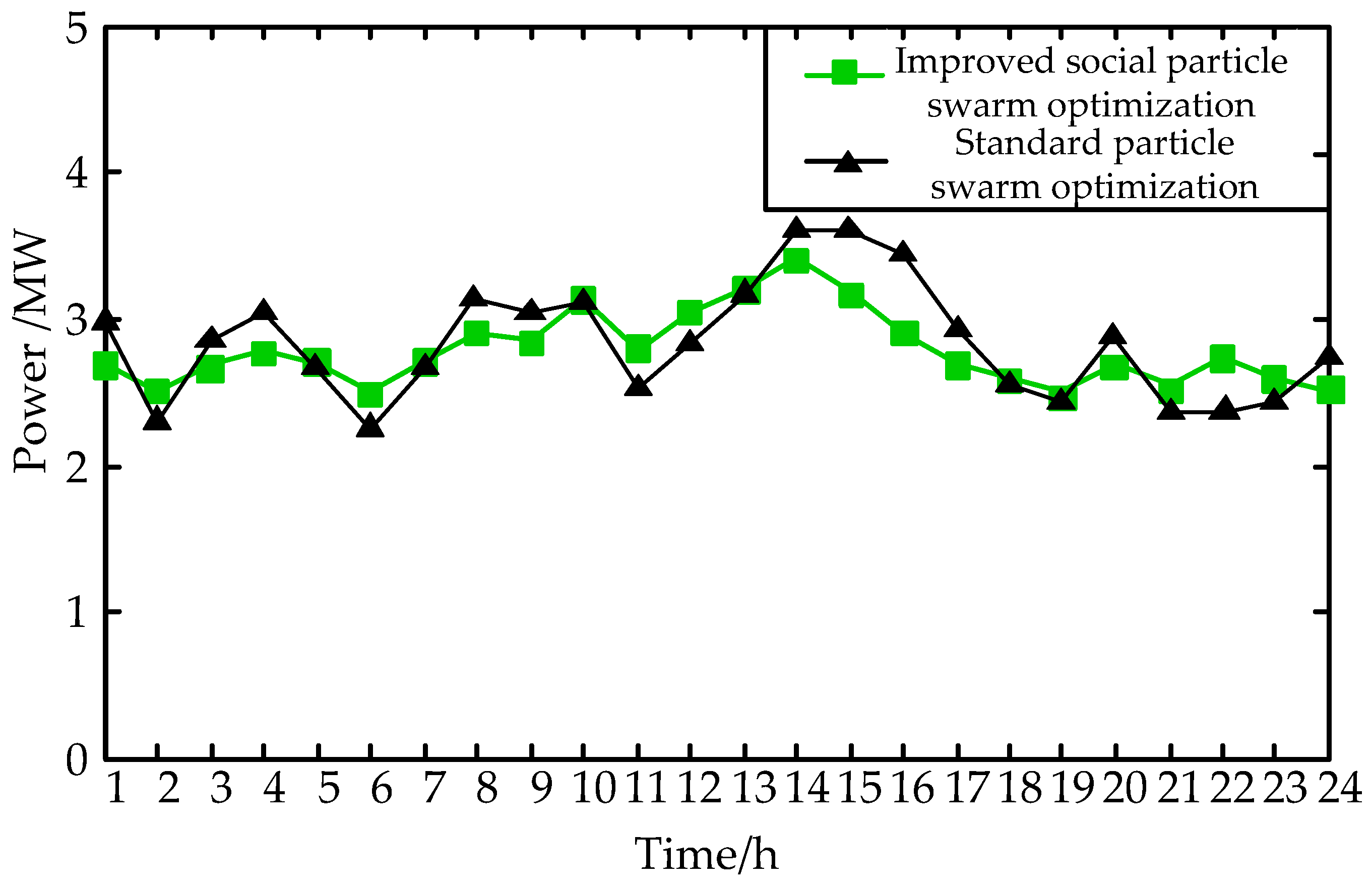
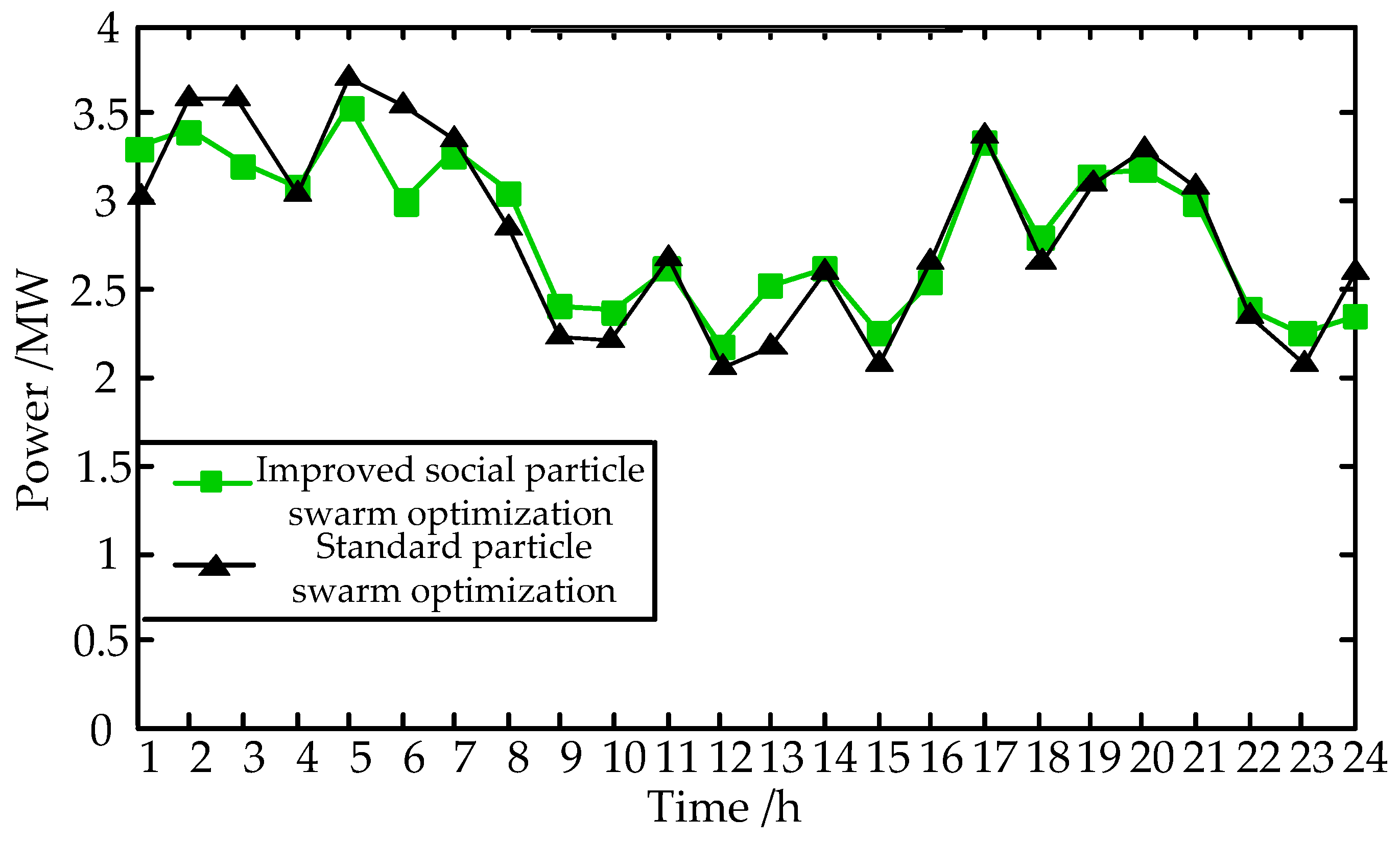

| Comparison of Results | Typical Day A | Typical Day B | Typical Day C | Typical Day D | ||||
|---|---|---|---|---|---|---|---|---|
| Wpass | Ppass (%) | Wpass | Ppass (%) | Wpass | Ppass (%) | Wpass | Ppass (%) | |
| Traditional strategy | 0.78 MW | 7.13 | 0.21 MW | 0.61 | 2.64 MW | 20.15 | 0.53 MW | 5.15 |
| New strategy | 0.27 MW | 2.54 | 0 | 0 | 0.94 MW | 9.12 | 0.15 MW | 1.23 |
| Comparison of Results | SPSO | Improved SPSO |
|---|---|---|
| Typical day A/times | 515 | 297 |
| Typical day B/times | 510 | 303 |
| Typical day C/times | 508 | 300 |
| Typical day D/times | 512 | 301 |
© 2020 by the authors. Licensee MDPI, Basel, Switzerland. This article is an open access article distributed under the terms and conditions of the Creative Commons Attribution (CC BY) license (http://creativecommons.org/licenses/by/4.0/).
Share and Cite
Wu, G.; Shao, X.; Jiang, H.; Chen, S.; Zhou, Y.; Xu, H. Control Strategy of the Pumped Storage Unit to Deal with the Fluctuation of Wind and Photovoltaic Power in Microgrid. Energies 2020, 13, 415. https://doi.org/10.3390/en13020415
Wu G, Shao X, Jiang H, Chen S, Zhou Y, Xu H. Control Strategy of the Pumped Storage Unit to Deal with the Fluctuation of Wind and Photovoltaic Power in Microgrid. Energies. 2020; 13(2):415. https://doi.org/10.3390/en13020415
Chicago/Turabian StyleWu, Guangyi, Xiangxin Shao, Hong Jiang, Shaoxin Chen, Yibing Zhou, and Hongyang Xu. 2020. "Control Strategy of the Pumped Storage Unit to Deal with the Fluctuation of Wind and Photovoltaic Power in Microgrid" Energies 13, no. 2: 415. https://doi.org/10.3390/en13020415
APA StyleWu, G., Shao, X., Jiang, H., Chen, S., Zhou, Y., & Xu, H. (2020). Control Strategy of the Pumped Storage Unit to Deal with the Fluctuation of Wind and Photovoltaic Power in Microgrid. Energies, 13(2), 415. https://doi.org/10.3390/en13020415





